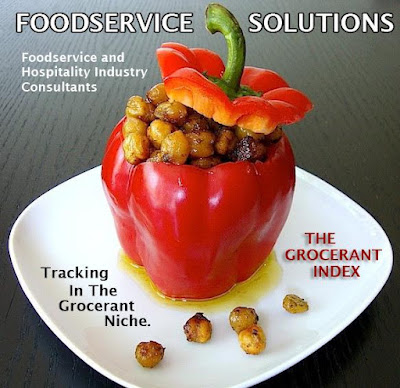Are
you wondering what’s for dinner again today—or even whether you’ll have
time to eat dinner at all? If your answer is yes, you’re not alone. In 2025,
over 72% of American consumers admit they don’t decide what’s for dinner
until after 3 PM, and more than 64% say they want meals they don’t have to
cook from scratch. Enter the grocerant niche—where Ready-2-Eat and
Heat-N-Eat meals are no longer fringe but fully mainstream.
Whether
you’re picking up food at a grocery store, convenience store, or even your
neighborhood drug store, what matters most is portability, variety,
and flavor fusion according to Steven Johnson Grocerant Guru® at Tacoma, WA
based Foodservice Solutions®. It’s
time to recognize that today’s dinner isn’t your mother’s meatloaf. It's a
curated mix-and-match of multi-ethnic, multi-flavor, fresh-prepared components,
bundled to make everyone happy—without the stress.
Food Evolution: From the Oven to the Car
Back
in the 1940s, a home-cooked meal took an average of 150 minutes to prepare.
Families sat together, and everyone ate the same thing. In 2025, the average
home “cooked” dinner takes just 24 minutes to assemble—often with two or
more different entrées to suit individual preferences. Today, it’s all about
convenience without compromise, and more often than not, that means not
cooking at all.
Restaurants
know this, too. Drive-thru’s now account for over 80% of fast-food traffic
in the U.S., and McDonald's has remodeled over 70% of its U.S. units to support
digital ordering, curbside pickup, and multiple drive-thru lanes. In fact,
their Riverside, CA flagship that once sparked headlines in 2012 with a 20%
bump in sales has become the model for the brand's broader digital-first
transformation. Today, that same location generates 65% of all orders
through mobile or app-based channels.
Retail Disruption: Walgreens, 7-Eleven, and More
No,
you’re not imagining it: Walgreens really is becoming a food competitor. With
over 8,600 locations, Walgreens has embraced the grocerant model in
dense urban areas, offering Grab-N-Go meal components by daypart. Think
hummus bento boxes, Thai peanut noodle bowls, and even chicken tikka masala for
dinner. Why? Because time-starved consumers want portability and diversity,
and Walgreens’ modular footprint allows for high-turn, low-labor execution.
Walgreens is no longer just a drug store—it’s a meal solution provider.
The
same goes for 7-Eleven, which now boasts more than 2,000 stores
in the U.S. with its "Evolution Store" concept offering fresh pizza,
birria tacos, and Korean BBQ rice bowls. And the kicker? Over 56% of these
sales now come from Ready-2-Eat meal bundles, driven by in-store
digital kiosks and delivery partnerships.
Grocerants Thrive with Flexibility and Flavor
Supermarkets
like Wegmans, Central Market, and Whole Foods continue to win by acting
more like restaurants—offering meals and meal components rather than just
ingredients. For example, Wegmans’ “Make It Your Way” dinner stations
now account for 18% of prepared foods revenue, offering choice-driven
assembly across Asian, Italian, and Mediterranean cuisines. These aren’t just
meals; they’re personalized family solutions.
Meanwhile,
retailers like Safeway and Kroger are trimming floor space and
replacing center-store aisles with hot bars, cold bars, and grab-and-go cases.
It’s working. Kroger’s Home Chef Express meals now sell in over 1,900
stores, and the brand recently surpassed $1 billion in annual sales.
Multicultural Meals = Family Harmony
Today’s
families are more multicultural than ever. That means a single dinner table may
require Thai, Tex-Mex, and vegetarian options—all in the same meal. Grocerant
strategies win by letting each family member select their own entrée or side
while still sharing a meal together. And because most consumers lack the
cooking skills for globally inspired meals, they prefer fresh-prepared
solutions that taste authentic but require no culinary know-how.
Case
in point: Foxtrot Market, a hybrid convenience-grocery store in urban
markets, has seen 45% of all evening orders include at least one
globally inspired dish like miso salmon or butter chicken. They’re not
selling snacks—they’re selling dinner with cultural relevance.
2025 Food Marketing Insights & Incremental Success
Recommendations
1.
Tap the Daypart Mindset Shift
Portability means more than packaging—it’s about fitting into a consumer’s
daily rhythm.
Example: Circle K now offers daypart-themed combos (breakfast
burrito + cold brew AM / wings + beer PM), growing average ticket size by 22%.
2.
Empower Customization Through Bundling
Let consumers build their own meal bundles to satisfy diverse family needs.
Example: H-E-B’s “Dinner Tonight” program lets shoppers bundle a
protein, side, and sauce from different cuisines—growing weeknight dinner
traffic by 17%.
3.
Extend the Meal Beyond the Store
Offer meal kits or ready-to-finish dishes to build brand relevance at home.
Example: Whole Foods' Chef’s Table To-Go line includes QR codes
for at-home plating tutorials and wine pairings, increasing cross-department
spend by 12%.
The Future of Dinner is Here—and It’s Portable
In
2025, dinner isn't a sit-down event bound by tradition—it’s a flexible,
flavorful, portable experience. Whether it comes from a grocery store, drug
store, or convenience outlet, the winning meal isn't just easy to get—it's easy
to love.
The
grocerant niche is no longer a trend—it’s the standard. If you're not selling fresh-prepared,
multi-ethnic, mix-and-match meals, you’re not just missing a sale—you’re
missing dinner.
Gain a Competitive Edge with a Grocerant ScoreCard
Unlock
new opportunities with a Grocerant ScoreCard, designed to optimize product
positioning, placement, and consumer engagement.
Since
1991, Foodservice Solutions® has been the global leader in the
Grocerant niche—helping brands identify high-growth strategies that
resonate with modern consumers.
📞
Call 253-759-7869 or 📩
Email Steve@FoodserviceSolutions.us









No comments:
Post a Comment